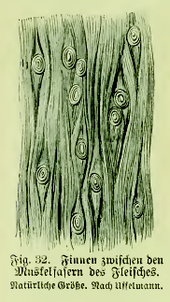Finn stage
The fin stage is understood to be the larval stage of a tapeworm , the larva of a tapeworm itself is called a fin . Meat infected by Finns is called finnish .
Finns are called differently according to their appearance:
- Echinococcal bladder , hydatide or metacestode are Finns of the tripartite dog tapeworm or fox tapeworm
- Procoid
- Plerozerkoid or full fin
- Cysticerkoid
- Cysticercus , bladder worm , or fin in the real sense denote the larval stage of the genus Taenia ( e.g. fish , beef and pork tapeworm )
By including ( ingestion ) of tapeworm eggs from the intestine of an infected host have been eliminated, an intermediate host infected. The Finns develop from the eggs and feed on the meat of the intermediate host and often lead to its death through organ failure . When the carcass is eaten by the carnivorous final hosts, the Finns eventually end up in its intestines, where they develop into adult tapeworms - the reproductive cycle can start all over again.
For the fish , beef and pork tapeworms, humans are the ultimate hosts who are only rarely seriously endangered by an infestation with adult worms. An infection of humans should be excluded as far as possible through the systematic meat inspection of beef and pork.
In contrast, the Finns of dog tapeworm ( Echinococcus granulosus ) and fox tapeworm ( Echinococcus multilocularis ) are dangerous for humans because they act as an intermediate host: the Finns themselves and not the adults are responsible for the disease. After infection, cystic (dog tapeworm) or alveolar echinococcosis (fox tapeworm), v. a. The latter can lead to death if left untreated.
For Finns, humans are a false host here, since their corpses are normally not eaten and the reproduction of the tapeworm is thus prevented. The intermediate hosts in dog and fox tapeworms are usually mice, rats and rabbits.
